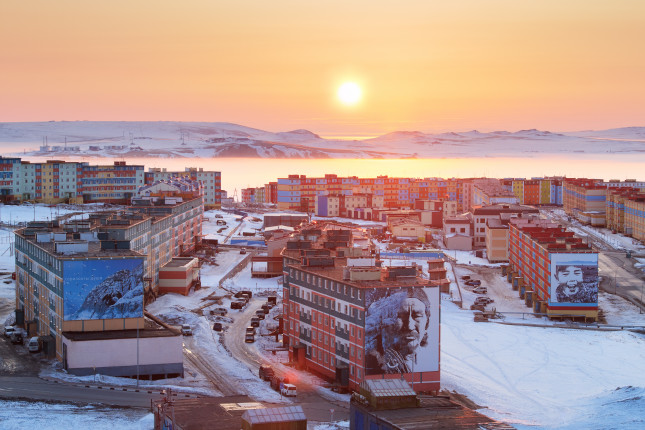-
Arctic Security Redefined: Human Security Through an Arctic Urban Lens
March 30, 2021 By Nadezhda Filimonova
“We are so few, we have no one to lose,” said Christina Henriksen, the president of Saami Council, during an interview on Coronavirus in the Arctic. The COVID-19 pandemic highlights the vulnerability of Arctic residents and the longstanding challenges related to the lack of sanitization, social infrastructure, and health service capacities. The impacts of the pandemic are coupled with the potential negative effects of climate change, including a 3-5 °C temperature increase projected over the Arctic Ocean by 2050.
To tackle these challenges, academics and policymakers should shift from thinking about the Arctic solely in terms of the economic and military interests of great power competition. Rather, academic research and political priorities for the Arctic should focus on enhancing Arctic communities’ resilience under continuing environmental and social changes in the polar region.
A focus on the human security of urban populations is an important vehicle for this integrated thinking. Arctic towns and cities serve as hubs for science, education, and innovation, along with being sites for energy, shipping, and tourism. They mainly consist of small and medium-sized settlements, with urban populations ranging from 10,000 to 300,000 people. Around two-thirds of Arctic populations are urban dwellers.
Arctic Urban Populations Face Unique Health Insecurities
Several external and internal factors have an impact on human security for Arctic urban dwellers. Primarily, the physical geography of Arctic cities, located in remote and isolated areas with harsh climate and weather conditions, poses a risk to the health of residents. People living in extreme weather conditions are exposed to low temperatures, snowstorms, avalanches, frost, and floods which often result in psychological trauma, including post-traumatic shock, and death. For instance, from 1979 through 1996, the age-adjusted rate for hypothermia-related deaths in Alaska was 10 times higher than in the rest of the United States. Health insecurities are also associated with depression, mental disorders, and diseases from the lack of exposure to natural sunlight during wintertime.
Furthermore, anthropogenic phenomena such as air, water, and soil pollution, caused by residential and local industrial activities, pose risks to human health in Arctic cities and towns. For example, residents of the city of Murmansk, Russia, have for years been breathing in coal shoot dust that wafts into the city from coal reloading at the Murmansk Commercial Seaport.
Environmental Insecurity is a Major Concern
Economic dependence on extractive industries, such as mineral resources production, closely links economic and environmental insecurity for some Arctic urban residents. For some Arctic cities, industry was built around the production of a single mineral, making them highly reliant on global demand. A sharp decline in demand for certain natural resources could lead to the closure of those industrial facilities, creating high rates of unemployment. In 2019, the Norilsk Nickel company’s decision to close its plant in Nikel, Russia, raised serious concerns among the local population about the potentially high rates of unemployment and the town’s future existence.
Climate change also poses risks. In summer 2017, in Greenland, wildfires swept over once icy tundra, coming dangerously close to towns. The warming climate poses risks to urban infrastructures, such as buildings, transport and communication systems, and facilities for water, waste, and energy. In Norilsk, the largest city built on permafrost in Russia, about 60 percent of buildings have been damaged by permafrost thaw.
Moreover, the impacts of climate change might worsen living conditions and trigger displacement of Arctic settlements, because of coastal line erosion, permafrost thawing, and flooding. The U.S. Government Accountability Office (GAO) revealed that 184 communities in Alaska were affected by flooding and shoreline erosion in 2003. In 2009, another GAO report identified 31 communities that were imminently threatened by flooding and erosion, of which 12 were considering relocation options.
Governance of Human Security in the Arctic
Considering that these security challenges are growing for the Arctic urban population, what policies or practices will be most effective to address present and future insecurities?
Apart from national policies, Arctic cities and their inhabitants have received attention at various international and regional political institutions. The Arctic Council—a leading regional intergovernmental forum—published several reports and initiated several projects to enhance the human security of Arctic communities. One such project, on solid waste management in small Arctic communicates, aimed to address health and environmental issues of residents in Alaska, Canada, and Finland. Furthermore, interest has been shown from the United Nations Human Settlements Program, which implemented an urban sustainable development project aimed at developing practices for promoting sustainable development in urban settlements in the Russian Arctic Zone.
Starting from May 2021, Russia will begin holding a two-year post of chairmanship of the Arctic Council. Since the Russian Arctic Zone is highly urbanized, there is an opportunity for raising awareness about problems and prospects for northern urban areas and their populations. Its chairmanship would also be an opportunity, if Russia chooses to act on it, to launch initiatives that are a departure from the traditional state-centric approach to human-centric comprehension of security in the Arctic. Russia should use its chairmanship to set an agenda for cooperation over minimizing impacts of climate change, upgrading urban infrastructure, and improving health systems to make Arctic urban population more resilient.
Nadezhda Filimonova is a Ph.D. Candidate at the University of Massachusetts Boston.
Sources: Arctic Council, Bellona, Bloomberg, Barents Observer, Centers for Disease Control, Journal of Arctic and Antarctic Research, Mental Health Nursing, Norwegian Refugee Council, Polar Record, Resources Policy, Studies on Russian Economic Development, United Nations Development Program, United Nations Environment Program, and U.S. Government Accountability Office
Photo Credit: Anadyr, Chukotka, Russia – May 7,2012. Sunrise over the city of Anadyr. Morning view of colorful buildings and sun over the horizon. Cold spring in the Arctic. Anadyr is the easternmost city in Russia, courtesy of Andrei Stepanov, Shutterstock.com.
 A Publication of the Stimson Center.
A Publication of the Stimson Center.



